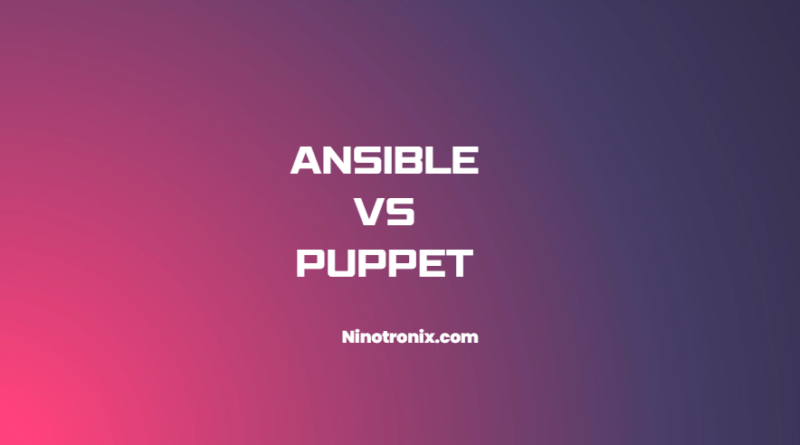Ansible vs. Puppet: Understanding the Differences and Choosing the Right Tool for Your Infrastructure
Configuration management tools enable system administrators to automate repetitive activities, manage IT infrastructure, and maintain consistency and security across multiple systems. Ansible and Puppet are two of the most widely used configuration management tools available today. Are you uncertain about which configuration management tool to use for your infrastructure? This blog article seeks to give a complete comparison of Ansible and Puppet, showing their similarities, differences, and use cases.
An Overview of Ansible and Puppet
Ansible and Puppet are two well-known configuration management tools for automating and managing IT infrastructure. They are meant to help system administrators in the deployment and configuration of software applications, as well as the management of servers and network devices. These tools also help in the automation of repetitive processes, the reduction of manual labor, and the enforcement of uniformity across the infrastructure.
Ansible and Puppet are both open-source tools with active communities that offer support, documentation, and plugins.
They include various features that simplify infrastructure administration, such as:
– Configuration management
– Infrastructure automation
– Remote execution
– Multi-node deployment
– Task scheduling
– Reporting and auditing
While both tools have certain features in common, there are many differences between them that make them more suited for specific use scenarios. In the following sections, we will look at the differences between these two tools in further detail.
Architecture and Workflow:
Architecture:
Ansible: Ansible is a push-based architecture, which means the control machine sends configuration changes to remote hosts over SSH or WinRM. To connect to remote machines, it uses a simple and agentless architecture that requires only SSH or WinRM credentials. Ansible’s playbooks are written in a YAML-based language, making them simple to comprehend and write.
Puppet: Puppet has a client-server architecture, which means there is a central server that controls and maintains the configuration changes of the client nodes. Puppet uses a master-slave approach in which the Puppet master controls configuration changes and the Puppet agents execute them. Puppet manifests are written in a domain-specific language called Puppet DSL, which is more sophisticated and difficult to grasp than Ansible’s YAML language.
Workflow:
Ansible: Ansible has a straightforward process consisting of three primary components: inventory, playbooks, and modules. The Inventory file includes a list of hosts that Ansible must manage, the Playbooks contain the actions that must be performed on the hosts, and the Modules are the tools used to complete these tasks. Ansible’s workflow is declarative, which means it describes the intended state of the system and then applies it.
Puppet: The Puppet methodology is similar to that of Ansible, but it uses a more complex and abstract model. It is made up of four major parts: nodes, catalogs, resources, and providers. The Nodes are the client machines that must be controlled, the Catalogues are the compiled configuration files that indicate the desired state of the system, the Resources are the tools for managing the system, and the Providers are the Resources’ implementation details.
Programming Languages and Syntax:
Ansible’s playbooks, which are a set of tasks to be done on managed nodes, are defined using YAML syntax. The YAML syntax is intended to be human-readable and simple to grasp. For dynamic data management, Ansible additionally uses the Jinja2 templating engine.
Puppet, on the other hand, defines infrastructure as code using its own declarative language called Puppet DSL (Domain Specific Language). The Puppet DSL is also human-readable, with an emphasis on the desired state of the infrastructure. For more sophisticated operations and dynamic data management, Puppet additionally employs an inbuilt Ruby DSL.
Resource Management and Modules:
Puppet uses a resource-centric approach in which each system resource is defined in the manifest file. Puppet comes with an array of built-in resource types (e.g., file, service, and package) and providers (e.g., apt, yum, systemd) that let you manage resources across several platforms. Puppet modules allow you to package and share related resources.
Ansible, on the other hand, has a task-centric approach in which tasks are defined and executed across a group of hosts. Ansible has a wide range of modules (for example, copy, file, and package) that enable you to handle various resources. These modules are platform-independent and utilize the same syntax on all systems. Ansible roles allow you to bundle and distribute related tasks.
In general, Puppet provides a more granular degree of control over resources and is better suited for managing large-scale settings with a high number of servers. Ansible, on the other hand, provides a simpler and more lightweight solution that is better suited for managing smaller settings or carrying out ad hoc operations.
Community and Ecosystem:
Puppet has a well-established ecosystem with a diverse set of modules and connectors, making it easy to find solutions to specific challenges. It also contains a greater number of certified modules, which means they have been tested for quality and compatibility by Puppet.
Ansible, on the other hand, offers a more flexible ecosystem with a greater number of modules. Furthermore, Ansible modules are more adaptable and may be used on a broader number of operating systems and platforms.
Both of them integrate with a variety of additional tools and platforms, such as cloud providers, CI/CD tools, and monitoring solutions. Ansible’s ecosystem, on the other hand, is more focused on DevOps automation and orchestration, whereas Puppet supports a broader variety of use cases, including configuration management, compliance, and security.
Use Cases and Best Practices:
Ansible Use Cases:
Configuration management: Ansible can be used to manage configurations across several servers, making it perfect for infrastructure as code and DevOps teams.
Continuous delivery: Ansible can be used as part of a continuous delivery pipeline to automate application testing, building, and deployment.
Puppet Use Cases:
Cloud automation: Puppet can be used to manage infrastructure in cloud environments such as AWS or Google Cloud Platform.
Compliance: Puppets can be used to enforce compliance regulations throughout an organization’s infrastructure, ensuring that security and regulatory requirements are satisfied.
Best Practices for Ansible:
Use playbooks: Playbooks make it easier to handle complicated activities and setups across several servers.
Use roles: Roles make it easy to reuse code and configurations across many playbooks.
Use Ansible Galaxy: Ansible Galaxy is a library of community-created roles and modules that can be simply incorporated into your playbooks.
Use variables: Variables make it easier to handle setups across many environments.
Best Practices for Puppet:
Use Puppet Forge: Puppet Forge is a community-created module repository that can be simply incorporated into your infrastructure.
Use modules: Modules make managing setups across many servers and environments easier.
Use Hiera: Hiera is a Puppet configuration data management solution that makes it easier to manage setups across many environments.
Use version control: Version control makes it easier to manage and monitor changes to your Puppet setups.
Ultimately, the choice between Ansible and Puppet is determined by the organization’s particular demands and limits, and it is always advisable to test both tools to figure out which one suits you best. To enable efficient and scalable automation, regardless of whether the tool is used, recommended practices such as code modularization, testing, and version control must be implemented. Thanks for reading.




